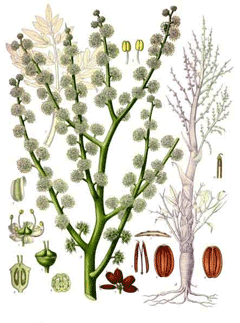 |
|
http://commons.wikimedia.org/wiki/File:Koeh-201.jpg |
 |
|
Translate this page:
Summary
Physical Characteristics

 Dorema ammoniacum is a PERENNIAL growing to 2.5 m (8ft) by 1 m (3ft 3in). The species is hermaphrodite (has both male and female organs) and is pollinated by Insects. The plant is self-fertile.
Dorema ammoniacum is a PERENNIAL growing to 2.5 m (8ft) by 1 m (3ft 3in). The species is hermaphrodite (has both male and female organs) and is pollinated by Insects. The plant is self-fertile.
Suitable for: light (sandy), medium (loamy) and heavy (clay) soils. Suitable pH: mildly acid, neutral and basic (mildly alkaline) soils. It can grow in semi-shade (light woodland) or no shade. It prefers dry or moist soil.
UK Hardiness Map
US Hardiness Map
Synonyms
Diserneston gummiferum
Plant Habitats
Cultivated Beds;
Edible Uses
References More on Edible Uses
Medicinal Uses
Plants For A Future can not take any responsibility for any adverse effects from the use of plants. Always seek advice from a professional before using a plant medicinally.
Antispasmodic Carminative Diaphoretic Diuretic Expectorant Poultice Stimulant Vasodilator
Ammoniacum has been used in Western herbal medicine for thousands of years and is still seen as an effective remedy for various complaints of the chest[254]. A gum resin is found in cavities in the tissues of stems, roots and petioles[4]. It often exudes naturally from holes in the stems caused by beetles[238] though this is not so pure as that obtained from the plant tissues[4]. The resin is antispasmodic, carminative, diaphoretic, mildly diuretic, expectorant, poultice, stimulant and vasodilator[4, 46, 64, 165, 238]. It is often used internally in the treatment of chronic bronchitis (especially in the elderly), asthma and catarrh[4, 238]. Externally, it is used as a plaster for swellings of the joints and indolent tumours[4, 238]. The resin exudes as a milky gum from holes made in the stems. This gum is pressed into blocks and then ground into a powder[254].
References More on Medicinal Uses
The Bookshop: Edible Plant Books
Our Latest books on Perennial Plants For Food Forests and Permaculture Gardens in paperback or digital formats.

Edible Tropical Plants
Food Forest Plants for Hotter Conditions: 250+ Plants For Tropical Food Forests & Permaculture Gardens.
More

Edible Temperate Plants
Plants for Your Food Forest: 500 Plants for Temperate Food Forests & Permaculture Gardens.
More

More Books
PFAF have eight books available in paperback and digital formats. Browse the shop for more information.
Shop Now
Other Uses
Porcelain Resin
A medicinal gum or resin called 'Ammoniacum' is exuded from insect damaged stems[46, 61, 64, 174]. It is also used in perfumery and in porcelain cement[238] as well as for plasters[46, 61, 64, 174].
Special Uses
References More on Other Uses
Cultivation details
Easily grown in an ordinary garden soil[1]. Prefers a well-drained to dry soil in a sunny position[238]. This species is not hardy in all parts of Britain, it tolerates temperatures down to at least -5°c[238]. A monocarpic species, growing for a number of years before it flowers but then dying after flowering[238]. It is said to produce viable seed in this country[238].
References Carbon Farming Information and Carbon Sequestration Information
Temperature Converter
Type a value in the Celsius field to convert the value to Fahrenheit:
Fahrenheit:
The PFAF Bookshop
Plants For A Future have a number of books available in paperback and digital form. Book titles include Edible Plants, Edible Perennials, Edible Trees,Edible Shrubs, Woodland Gardening, and Temperate Food Forest Plants. Our new book is Food Forest Plants For Hotter Conditions (Tropical and Sub-Tropical).
Shop Now
Plant Propagation
Seed - sow in an outdoor seedbed in April[175]. It might be better to sow the seed in the autumn in a cold frame or greenhouse[K]. The seed germinates in 2 - 6 weeks at 15°c[175]. If seed is in short supply we would recommend sowing it in a pot in a cold frame and pricking out the seedlings into individual pots as soon as they are large enough to handle. Plant them out into their permanent positions in late spring of the following year.
Other Names
If available other names are mentioned here
Native Range
TEMPERATE ASIA: Iran
Weed Potential
Right plant wrong place. We are currently updating this section.
Please note that a plant may be invasive in one area but may not in your area so it's worth checking.
Conservation Status
IUCN Red List of Threatened Plants Status :

Growth: S = slow M = medium F = fast. Soil: L = light (sandy) M = medium H = heavy (clay). pH: A = acid N = neutral B = basic (alkaline). Shade: F = full shade S = semi-shade N = no shade. Moisture: D = dry M = Moist We = wet Wa = water.
Now available:
Food Forest Plants for Mediterranean Conditions
350+ Perennial Plants For Mediterranean and Drier Food Forests and Permaculture Gardens.
[Paperback and eBook]
This is the third in Plants For A Future's series of plant guides for food forests tailored to
specific climate zones. Following volumes on temperate and tropical ecosystems, this book focuses
on species suited to Mediterranean conditions—regions with hot, dry summers and cool, wet winters,
often facing the added challenge of climate change.
Read More
Expert comment
Author
D.Don.
Botanical References
174
Links / References
For a list of references used on this page please go here
Readers comment